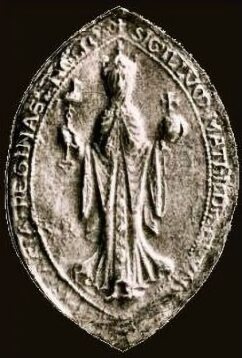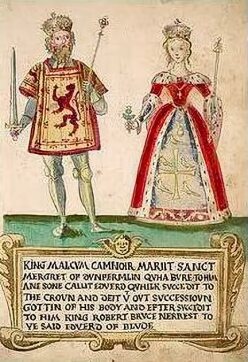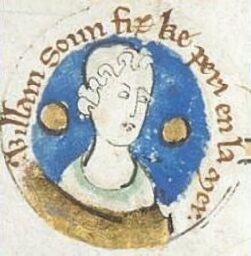Queen of England
Edith of Scotland was born circa 1080 at Dunfermline, she was the daughter of Malcolm III King of Scots 'Canmore' and Saint Margaret.
Her mother Margaret Atheling was born of the ancient Saxon House of Wessex, she was the daughter of Edward Atheling, otherwise known as 'Edward the Exile' and Agatha (possibly a niece of Henry III, Emperor of Germany) and was born in Hungary in 1046. In 1068, Margaret's brother, Edgar Atheling joined in rebellion with the northern Earls Edwin and Morcar against William's rule and shortly after the family were forced to flee, their ship was driven by storms to the Scottish coast, where they were welcomed at the court of King Malcolm Canmore. Malcolm Canmore, a widower, was attracted to the beautiful Saxon princess and no doubt the prospect of an alliance with the ancient Anglo-Saxon royal house was an added attraction. The couple were married sometime before the end of 1070.
Seal of Edith of Scotland
Robert Curthose, the eldest son of William the Conqueror stood as godfather at the christening of Edith of Scotland. While Queen Matilda of Flanders, William's wife also stood as her godmother. Queen Margaret, a pious woman who was later canonized, is described as a strict but loving mother to her children.
At the age of around six, Edith and her sister Mary were sent to receive an education at Romsey Abbey, near Southampton, where their mother's sister Christina was abbess and at Wilton Abbey, near Salisbury. She was taught English, French, and some Latin. During her time at the abbey, Edith received a proposal from William de Warenne, 2nd Earl of Surrey which she turned down.
Malcolm and Canmore and St. Margaret, the parents of Edith of Scotland
Edith's parents betrothed her to Alan Rufus, Lord of Richmond, in 1093, but, before the marriage was celebrated, her father quarreled with William Rufus, the King of England regarding the boundaries of Cumbria and Lothian. William Rufus, after driving the Scots north of the Solway, invited their King for talks. On the Scottish King's arrival at Gloucester, William delivered a stinging snub to Malcolm by refusing to receive him. Enraged at the insult to his dignity, Malcolm returned to Scotland and retaliated by riding with an army into Northumbria.
On 13th November 1093, on accepting the surrender of the Castle of Alnwick, Malcolm leaned forward from his horse to receive the keys from the point of the lance of its keeper, when the lance was treacherously thrust into his eye. He died in agony, his eldest son by Margaret, Edward, was also killed. The throne of Scotland was seized by Malcolm's brother Donald Bane. The disastrous news was carried to Margaret at Edinburgh Castle, the Queen was already mortally ill and the castle was under siege by her brother-in-law. She died three days later, leaving Edith an orphan. Alan Rufus, whom she was still betrothed to was betrothed to Gunhild of Wessex, a daughter of Harold Godwinson, instead, but died before the marriage could take place.
On the death of William Rufus in August 1100, the throne of England was seized by his youngest brother, who became Henry I, who wished to marry Edith. William of Malmesbury relates that Henry had "long been attached" to her, and Orderic Vitalis says that Henry had "long adored" her character. Henry had been born in England, he needed a bride with ties to the ancient Saxon line to increase his popularity with the English people and to reconcile the Normans and Anglo-Saxons.
Because the Scottish princess had spent most of her life in a convent, there was some controversy over whether she had taken vows as a nun, which would have rendered her ineligible for marriage. Henry sought permission for the marriage from Archbishop Anselm, who called a council of bishops in order to determine the canonical legality of the proposed marriage. Edith testified to the council that she had never taken holy vows, insisting that her parents had sent her and her sister to England for educational purposes, and her aunt Christina had veiled her to protect her "from the lust of the Normans." She claimed she had pulled the veil off and stamped on it, and her aunt beat and scolded her for this act. The council concluded that Edith was not a nun and her parents had not intended that she become one, and granted their permission for the marriage of Edith and Henry.
William the Atheling
Edith and Henry were married on 11th November 1100 at Westminster Abbey by Archbishop Anselm of Canterbury, she was crowned queen as Matilda, a Norman name.
Their first child, a daughter, Euphemia, was born in July/August 1101 but died young. She was followed by Matilda, born in February 1102, her only son, William, known as 'the Atheling' was born in November 1103, a fourth child, Elizabeth arrived in August/September 1104-, but like her eldest sister, she died young. The marriage led to improved relations with Scotland. Matilda often acted as regent for her husband during his frequent absences. During the English investiture controversy (1103-07), she acted as an intercessor between her husband and archbishop Anselm. Matilda commissioned a monk, possibly Thurgot, to write a biography of her mother, Saint Margaret.
Following the example of her saintly mother, Matilda devoted herself to good causes and often washed the feet of the poor. Though Henry was seldom faithful to his Queen, their's was generally considered a good and happy marriage by royal standards and helped to unite the rival claims of the Norman and Saxon houses.
Henry I proved to be a serial adulterer and begat more illegitimate children than any other English King , in all he fathered twenty bastards, by a continuous string of mistresses. One of these was the beautiful Nesta, Princess of Wales, who became the mother of the King's son, Henry. By far the most famous of Henry's illegitimate offspring was Robert of Caen, later created Earl of Gloucester, he was born in 1090, by a Norman mother, before Henry came to the English throne and was later to play a leading part on the stage of English history. Sybil, his daughter by Sybil Corbet, who was born in the 1090's was married to Alexander 'the Fierce', King of Scots, the brother of Henry's Queen, Edith.
Matilda died on 1st May 1118 at Westminster Palace and was buried at Westminster Abbey. Two years later, her son, William, was drowned in the English Channel in the wreck of the White Ship on 25th November 1120. Henry I, remarried in the hope of producing a male heir. Henry and Edith's daughter Matilda, became the mother of Henry II, first of the Plantagenet kings of England.
The Ancestry of Edith of Scotland
Edith of Scotland Father:
Malcolm III, King of Scots
Paternal Grandfather: Duncan I, King of Alba
Paternal Great-grandfather: Crínán of Dunkeld
Paternal Great-grandmother: Bethóc of Scotland
Paternal Grandmother: Suthen
Mother: St. Margaret of Wessex
Maternal Grandfather: Edward the Exile
Maternal Great-grandfather: King Edmund II Ironside
Maternal Great-grandmother: Edith
Maternal Grandmother: Agatha
William Peverel PreviousNext William the Atheling
